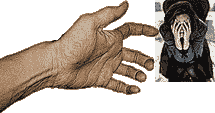Vegetative State, part II
So what defines when someone’s alive?
Okay, I wrote about Terri Schiavo before. Everyone was having a fit about her husband being able to cut off her life support, but he had the right to choose, and based on all medical evidence they could muster (even check out the cat scan of her brain versus a normal person’s brain, like I had highlighted in that past interview), there was so much brain damage to Terri that there was no way she could ever be responsive — if there was ever any chance that she could regain consciousness (which seemed an impossible option for her). But people had hope, even beyond all hope — like her parents, who only started showing concern for their daughter (oh wait, that sounds rude, scratch that) who only started visiting her often, in the last years of Terri’s unconscious life in the hospital, because they feared their son would terminate her life. Keep in mind that her parents didn’t even bother seeing her for years — I mean years — while she was laying in her (in their words) attentive state.
Okay, sorry I’m going on with that first editorial about Terri Schiavo. I’m talking about this again because I just read an AP article in the Naples Daily News titled ̶-;Brain Scan Detects Signs of Awareness in Vegetative-State Patient.” Now, this article went on about how British scientists (led by neuroscientist Adrian Owen of the British Medical Research Council) reported that ̶-;advanced Brain scanning uncovered startling signs of awareness” in a woman who was in a vegetative state. Now, I’m sure this argument is going to bring up the Terri Schiavo reference, but this story was based on a woman who was (1) younger, and (2) in a vegetative state for a much shorter time, and (3) did not show the same signs of brain deterioration that Terri Schiavo did. Beyond just MRI scans, they relied of functional MRI, or fMRI... and this concluded that this patient in question actually had brain activity responses when given instruction of what to think about (playing tennis, then going for a walk). This fMRI showed ̶-;brain region reactions in the same way” this patient and a healthy volunteer did. This showed that the patient – who was in a vegetative state for only five months —seemed to (at least) mentally certain commands, led people from the study to conclude that this patient ̶-;decided to involve herself in the study and do what we asked.” Even though is could be viewed that she responded mentally to commands, they also wonder if her brain was just responding more automatically to speech.
And yes, this does sound promising — as Lionel Naccache if INSERM (France’s national science institute) wrote in a review, for someone not as badly injured and someone like Terri Schiavo, and someone who had not been in a vegetative state that long (as was the case in this single study). This study applies to people who are not conscious. But ̶-;the machinery is still there and operating,” quoting Joy Hirsch of New York Columbia University’s Medical Center.
So if you’re looking for a verdict or a point, and you’re wondering if I’ll change my mind, sorry, I won’t. What I will say is that with more and more medical breakthroughs, maybe doctors can learn more ways to know if someone who has just entered into a vegetative state has any chance of leaving that state — if their brain is still functioning. For every bit of evidence collected for Terri Schiavo, it was apparent that she was never going to come out of that vegetative state, because she didn’t have enough brain matter to help her survive... But maybe, for those who have just entered into a state like this, maybe there is medical hope that will help people know if their loved one who has just been so severely injured has a chance of surviving...
(P.S.: Because of a previous accident of mine, where I was unconscious for eleven days and had to relearn how to walk and talk and eat, the doctors but a Vena Cava filter in my body — a small piece of metal in my torso along a vial blood line to stop any blood clots from traveling north to my heart or lungs or brain. Thanks to this little piece of metal, I can never have an MRI (much less a fMRI). So... Doctors better keep working on ways to help people in these conditions, so the likes of me don’t remain out of luck...)


Copyright Janet Kuypers.
All rights reserved. No material
may be reprinted without express permission.
|

![]()




![]()

![]()

![]()




![]()

![]()